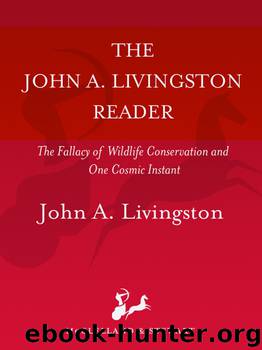The John A. Livingston Reader by John Livingston

Author:John Livingston [Livingston, John A.]
Language: eng
Format: epub
ISBN: 978-1-55199-255-6
Publisher: McClelland & Stewart
Published: 2007-01-22T16:00:00+00:00
FOUR
The NUMBERS GAME
Whether there is “purpose” in life is questionable, but there are definite trends. Biologically, the trend is toward diversity and variety, in order that the stable equilibrium of ecosystems may be maintained. Trends must involve a force, and the fundamental force in living organisms is reproduction. It would seem that the object of all living beings is to produce as many offspring as possible in order that a sufficient number may survive the exigencies of existence to replace those continuously being lost to natural attrition. In some parts of the world, men want to have many sons to ensure that there will be someone to care for them in their later years. In nature, the attempt is to deal with the overwhelming odds against the survival of any individual or group of offspring.
A population consists of all individuals of one species in a given community. In studying natural populations, there are a number of elements involved. How dense is the population: how many individuals of that kind of organism are there in the area being observed? In the case of some invertebrates, one might be counting numbers per square foot; in the case of redwinged blackbirds, numbers per acre; in the case of deer, numbers per square mile.
The density of a population of animals is partly a reflection of the species’ birth rate. Animals and plants have spectacularly different birth rates, according to their ways of life and their roles in the community. Plants, which are the primary food producers and are eventually devoured by everyone in the community (including each other), must perforce have a high rate of reproduction. Vegetarian animals in general have higher birth rates than meat-eating animals, because as primary converters they too are suppliers to the food pyramid. Their “turnover” is high. To understand what is happening to animal populations we must know not only the birth rate of a species but also its rate of turnover, and this involves its death rate.
Assessing populations is difficult. Many organisms are anything but sedentary. They come and go. Populations in local areas do not remain static. Nothing in nature does. There are individuals who, for various reasons, move away into new communities, and there are those who wander into an area from outside.
Despite fluctuations, natural populations (with such exceptional phenomena as lemming cycles) give the appearance of being relatively stable. Birdwatchers notice minor or even major changes in some species over periods of several years, but they also learn to expect reasonably dependable relative populations of the most familiar species. It was once thought that some mysterious mechanism was built into a species which prevented its numbers from “exploding”; somehow the birth and death rate were counterbalanced. However, this is not the case. Changes in the environment of a species may have extraordinary consequences; one change might wipe out an animal completely, while another might allow it to increase at an incredible rate. This is precisely what has happened with the human species, and it has been observed in many others.
Download
This site does not store any files on its server. We only index and link to content provided by other sites. Please contact the content providers to delete copyright contents if any and email us, we'll remove relevant links or contents immediately.
The Lonely City by Olivia Laing(4748)
Animal Frequency by Melissa Alvarez(4395)
All Creatures Great and Small by James Herriot(4232)
Walking by Henry David Thoreau(3893)
Exit West by Mohsin Hamid(3777)
Origin Story: A Big History of Everything by David Christian(3648)
COSMOS by Carl Sagan(3554)
How to Read Water: Clues and Patterns from Puddles to the Sea (Natural Navigation) by Tristan Gooley(3406)
Hedgerow by John Wright(3275)
The Inner Life of Animals by Peter Wohlleben(3259)
How to Read Nature by Tristan Gooley(3249)
How to Do Nothing by Jenny Odell(3232)
Project Animal Farm: An Accidental Journey into the Secret World of Farming and the Truth About Our Food by Sonia Faruqi(3177)
Origin Story by David Christian(3147)
Water by Ian Miller(3127)
A Forest Journey by John Perlin(3027)
The Plant Messiah by Carlos Magdalena(2883)
A Wilder Time by William E. Glassley(2818)
Forests: A Very Short Introduction by Jaboury Ghazoul(2790)
